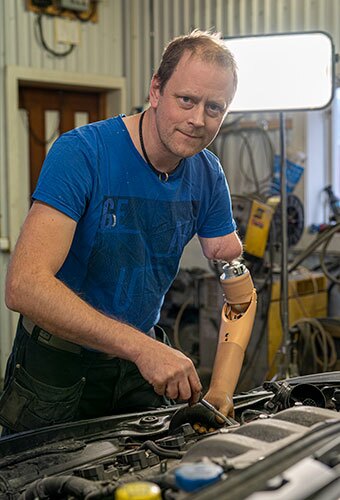An international team of scientists is reporting success with one of the most advanced bionic arms ever made. The system is integrated into the patient’s nerves, allowing them to control the prosthesis just by thinking about it, the way you would with the natural limb. Better yet, it feeds the sensation of touch back to the brain. Three patients have now lived with the system for several years.
The groundbreaking study was conducted by researchers from Chalmers University of Technology, Sahlgrenska University Hospital, University of Gothenburg, Integrum AB, Medical University of Vienna, and MIT.
Unlike traditional socket protheses that basically just slot over the stump of a limb, the new system is a neuromusculoskeletal prosthesis. That means it interfaces directly with the nerves and muscles of the stump, so users can control it with their own minds in a realistic way. According to the researchers, the feeling is so lifelike that the participants didn’t even need to be trained to use it, like many other devices.
The prosthesis is surgically attached to the remaining section of the patient’s limb, anchored to the bone for stability. Electrodes are implanted into the muscles and nerves, so the user can open and close their hand and feel sensory feedback.

For that second part, force sensors are built into the prosthesis’ thumb, which measure contact and pressure. That information is then sent to the brain, letting the user feel when they’re touching something, tell its characteristics, and determine how hard they’re pressing on it. All of this is crucial information for a prosthetic arm to feel like the real thing.
The researchers say that three Swedish patients have now lived with the device for between three and seven years. And so far it’s shown to be safe, stable and useful.
“The prosthesis has changed my life a lot,” says one of the study participants. “The traditional socket prosthesis I had before was a tool I wore. The new prosthesis does not feel like something I wear but as part of me. I use it all day, so for me it's so natural, it's not something I really think about.”

The new sensing system can apparently be connected to a variety of different prosthetic devices. With the success of the current study, the team hopes to expand the system’s use to other regions and types of prostheses.
“Right now, patients in Sweden are participating in the clinical validation of this new prosthetic technology for arm amputation,” says Max Ortiz Catalan, lead researcher on the study. “We expect this system to become available outside Sweden within a couple of years, and we are also making considerable progress with a similar technology for leg prostheses, which we plan to implant in a first patient later this year.”
The research was published in the New England Journal of Medicine. The team describes the work in the video below.
Sources: Chalmers University of Technology, Medical University of Vienna







